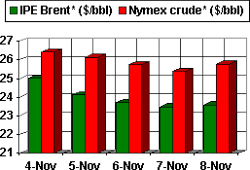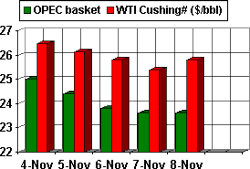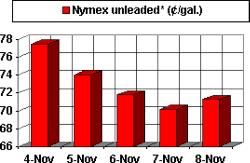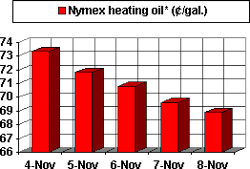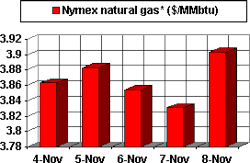While the near-term outlook for natural gas prices remains volatile, there continues to be healthy case-building for a step change in gas pricing fundamentals in the coming years.
The cold wave sweeping much of North America near the early part of this month helped nudge industry into its first storage withdrawal of the season. According to US Energy Information Administration data, operators withdrew 27 bcf of gas from storage during the week ended Nov. 1. That compares with injection into storage of 11 bcf the prior week and a 25 bcf average injection for the same week over the preceding 5 years.
That has pushed storage levels into their first year-on-year deficit since the end of May 2001. The deficit is likely to get deeper with this week's storage report from the EIA, given the contuinuation of cool weather into last week. Storage levels are now pretty much on track with where they need to be to give consumers some comfortif not giving producers anythis winter, within less than 150 bcf of the previous 5 year average.
But the odds are that gas prices will continue to ease off their recent rally to a level topping $4/MMbtu this winter. The average October composite spot price was $3.69/MMbtu, up sharply from the September average of $3.13/MMbtu. But UBS Warburg predicts spot prices could slip below its forecast of $3.65-3.80/MMbtu for November-December as economic concerns and a return to mild weather put a damper on demand.
Bullish upside
Even if the near-term fundamentals overall look bearish, Henry Hub gas prices could readily top $4/MMbtu and approach $5/MMbtu before the year is out.
Energy Security Analysis Inc., Boston, said, "Strong technical signals coming from the bullish channel that has developed since the winter of 2000-01 indicate that, before the end of the year, technical trading could take prompt month beyond $4.45/MMbtu."
But there's a cap on this upside forecast as fundamentals come back into play, likely toward the end of December and into January-February. Gas prices could "come off hard in the new year, pushing well below $3/MMbtu by March," ESAI said.
Step-change case
For some months now the view has been emerging that the North American gas sector is headed for a step changea view predicated on the notion that wellhead deliverability is inexorably shrinking, particularly in the US.
This analysis has hinged largely on the nature of well producibilityhow individual gas wells are producing smaller volumes and how their production peaks more quickly than before.
Now we have another view of US gas deliverability's decline, but this time spun from a Wall Street angle. RBC Capital Markets contends that the North American exploration and production sector has grown and matured and thus is less likely to respond quickly to unsustainable commodity prices than in the past. Because industry drilling and production trends are evolving into a more return-sensitive mode, there is likely to be less activity directed to short-term production maximization (as in last year's flurry of opportunistic gas drilling). With this trend in place, production will decline even more, ratcheting up the price floor for natural gas.
"Over time, we expect markets will be willing to discount higher natural gas prices as the level of sustainable price migrates higher to accommodate more nonconventional production," RBC said. "Constrained activity will also allow for a more attractive cost structure."
What has pushed this trend? According to RBC, investors have begun demanding E&P returns commensurate with inherent risk and more reflective of the relatively strong price environment.
So independents in particular will be chasing fewer but bigger prospects in the US and Canada and will be looking increasingly abroad for company growth.
After 1986, it took a massive collapse in oil prices to force E&P operators into this same new modeafter years of throwing too much good money at too many bad prospects because of general giddiness over the perceived future of oil prices.
This time around, the step change can be traced to the downfall of Enron Corp. and the other corporate scandals that followed. Apart from the misery energy merchants are feeling now as a result, most of the pain incurred at E&P companies will relate to increased transparency of their operations and greater fiscal discipline needed to position themselves as long-term attractive investments.
Not a bad trade-off for $4-5/MMbtu gas.
OGJ Hotline Market Pulse
Latest Prices as of Nov. 11, 2002
null
null
Nymex unleaded
null
Nymex heating oil
null
IPE gas oil
null
Nymex natural gas
null
NOTE: Because of holidays, lack of data availability, or rescheduling of chart publication, prices shown may not always reflect the immediate preceding 5 days.
*Futures price, next month delivery. #Spot price. @New contract
